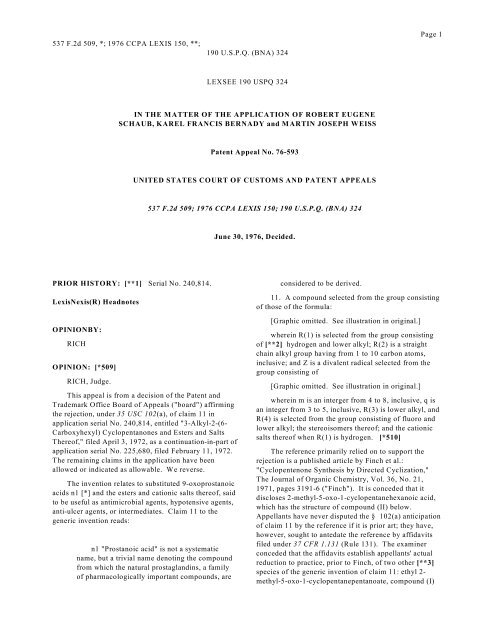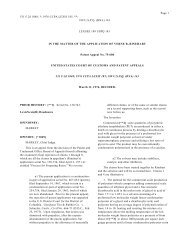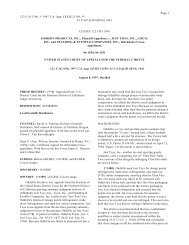537 F.2d 509, *; 1976 CCPA LEXIS 150, **; 190 USPQ (BNA) 324 ...
537 F.2d 509, *; 1976 CCPA LEXIS 150, **; 190 USPQ (BNA) 324 ...
537 F.2d 509, *; 1976 CCPA LEXIS 150, **; 190 USPQ (BNA) 324 ...
Create successful ePaper yourself
Turn your PDF publications into a flip-book with our unique Google optimized e-Paper software.
<strong>537</strong> <strong>F.2d</strong> <strong>509</strong>, *; <strong>1976</strong> <strong>CCPA</strong> <strong>LEXIS</strong> <strong>150</strong>, <strong>**</strong>;<strong>190</strong> U.S.P.Q. (<strong>BNA</strong>) <strong>324</strong>Page 1LEXSEE <strong>190</strong> <strong>USPQ</strong> <strong>324</strong>IN THE MATTER OF THE APPLICATION OF ROBERT EUGENESCHAUB, KAREL FRANCIS BERNADY and MARTIN JOSEPH WEISSPatent Appeal No. 76-593UNITED STATES COURT OF CUSTOMS AND PATENT APPEALS<strong>537</strong> <strong>F.2d</strong> <strong>509</strong>; <strong>1976</strong> <strong>CCPA</strong> <strong>LEXIS</strong> <strong>150</strong>; <strong>190</strong> U.S.P.Q. (<strong>BNA</strong>) <strong>324</strong>June 30, <strong>1976</strong>, Decided.PRIOR HISTORY: [<strong>**</strong>1] Serial No. 240,814.LexisNexis(R) HeadnotesOPINIONBY:RICHOPINION: [*<strong>509</strong>]RICH, Judge.This appeal is from a decision of the Patent andTrademark Office Board of Appeals ("board") affirmingthe rejection, under 35 USC 102(a), of claim 11 inapplication serial No. 240,814, entitled "3-Alkyl-2-(6-Carboxyhexyl) Cyclopentanones and Esters and SaltsThereof," filed April 3, 1972, as a continuation-in-part ofapplication serial No. 225,680, filed February 11, 1972.The remaining claims in the application have beenallowed or indicated as allowable. We reverse.The invention relates to substituted 9-oxoprostanoicacids n1 [*] and the esters and cationic salts thereof, saidto be useful as antimicrobial agents, hypotensive agents,anti-ulcer agents, or intermediates. Claim 11 to thegeneric invention reads:n1 "Prostanoic acid" is not a systematicname, but a trivial name denoting the compoundfrom which the natural prostaglandins, a familyof pharmacologically important compounds, areconsidered to be derived.11. A compound selected from the group consistingof those of the formula:[Graphic omitted. See illustration in original.]wherein R(1) is selected from the group consistingof [<strong>**</strong>2] hydrogen and lower alkyl; R(2) is a straightchain alkyl group having from 1 to 10 carbon atoms,inclusive; and Z is a divalent radical selected from thegroup consisting of[Graphic omitted. See illustration in original.]wherein m is an interger from 4 to 8, inclusive, q isan integer from 3 to 5, inclusive, R(3) is lower alkyl, andR(4) is selected from the group consisting of fluoro andlower alkyl; the stereoisomers thereof; and the cationicsalts thereof when R(1) is hydrogen. [*510]The reference primarily relied on to support therejection is a published article by Finch et al.:"Cyclopentenone Synthesis by Directed Cyclization,"The Journal of Organic Chemistry, Vol. 36, No. 21,1971, pages 3191-6 ("Finch"). It is conceded that itdiscloses 2-methyl-5-oxo-1-cyclopentanehexanoic acid,which has the structure of compound (II) below.Appellants have never disputed the § 102(a) anticipationof claim 11 by the reference if it is prior art; they have,however, sought to antedate the reference by affidavitsfiled under 37 CFR 1.131 (Rule 131). The examinerconceded that the affidavits establish appellants' actualreduction to practice, prior to Finch, of two other [<strong>**</strong>3]species of the generic invention of claim 11: ethyl 2-methyl-5-oxo-1-cyclopentanepentanoate, compound (I)
<strong>537</strong> <strong>F.2d</strong> <strong>509</strong>, *; <strong>1976</strong> <strong>CCPA</strong> <strong>LEXIS</strong> <strong>150</strong>, <strong>**</strong>;below, and 2-methyl-5-oxo-1-cyclopentaneheptanoicacid, compound (III) below.[Graphic omitted. See illustration in original.][*511]The examiner, the board, and the solicitor have notdisputed these facts but only their legal sufficiency toantedate Finch.The Board's DecisionThe board supported its decision in part by referenceto our opinion in In re Clarke, 53 <strong>CCPA</strong> 954, 356 <strong>F.2d</strong>987, 148 <strong>USPQ</strong> 665 (1966):In commenting on a situation very similar to the oneherein, the court in In re Clark * * * stated that a citedreference may be antedated if the facts:"... offerred [sic] in a rule 131 affidavit in support ofa general allegation of conception and reduction topractice of the invention, would persuade one of ordinaryskill in the art to a reasonable certainty that the applicantpossessed so much of the invention as to encompass thereference disclosure ...."On the basis of the above cited Clarke language, theboard held Clarke to apply as follows:Accordingly, if the only reasonable interpretation ofthe facts contained in the noted affidavits [<strong>**</strong>4] is thatappellants viewed their invention as embracing a seriesof homologous acids, we would be constrained to agreethat they had antedated the Finch et al. referencecompound.So applying Clarke, the board expressed its view asfollows:However, we do not agree that there is only onereasonable conclusion that a worker of routine skill inthis field would reach, based upon the available facts.The board noted that appellants' compounds (I) and(III) had the same empirical formula, a fact to which theboard gave great significance:It will be appreciated that said compounds may becharacterized as isomers. Hence, from the evidence, webelieve that the skilled worker would be persuaded, to areasonable certainty, that appellants envisioned theirgeneric invention to concern isomeric norprostanoic acidcompounds having thirteen carbon atoms. Such isomerswould not encompass the reference disclosure.The board stated that "still another interpretation"was suggested by a publication of M. Hamberg,"Metabolism of Prostaglandins in Rat LiverMitochondria," European Journal of Biochemistry, 6,1968, pp. 135-46 (hereafter "Hamberg"):Said item indicates that prostaglandins [<strong>**</strong>5] are<strong>190</strong> U.S.P.Q. (<strong>BNA</strong>) <strong>324</strong>Page 2subject to betaoxidation in rat liver mitochondria. Invitro experiments showed that the carboxyl side chain ofsaid acid is degraded by one or two C(2) units.Therefore, since the compounds having an even numberof carbon atoms in the side chain would seem toapproximate naturally occurring compounds in the body,the preparation and testing of such compounds having aneven number of carbon atoms in the chain does not, initself, prove that appellants contemplated all homologouscompounds, including those with an odd number ofcarbon atoms.Appellants' ArgumentsAppellants argue that the disposition of this caseshould be governed by the following proposition:In an appropriate case an applicant should not beprevented from obtaining a [*512] patent to aninvention where a compound described in a referencewould have been obvious to one of ordinary skill in theart in view of what the affiant proves was completed withrespect to the invention prior to the effective date of thereference.Like the board, appellants also found their argumenton In re Clarke, from which the above proposition is adirect quotation.Appellants contend that the reference compound[<strong>**</strong>6] (compound II) is obvious in view of compounds Iand III, which they reduced to practice before the date ofthe Finch reference. They state that they have"bracketed" the reference compound with its twoadjacent homologs, n2 thus raising a "presumption ofobviousness vis-a-vis the reference compound," citing Inre Hass, 31 <strong>CCPA</strong> 895, 141 <strong>F.2d</strong> 122, 60 <strong>USPQ</strong> 544(1944); In re Henze, 37 <strong>CCPA</strong> 1009, 181 <strong>F.2d</strong> 196, 85<strong>USPQ</strong> 261 (1950); In re Mills, 47 <strong>CCPA</strong> 1185, 281 <strong>F.2d</strong>218, 126 <strong>USPQ</strong> 513 (1960); and In re Stemniski, 58<strong>CCPA</strong> 1410, 444 <strong>F.2d</strong> 581, 170 <strong>USPQ</strong> 343 (1971), sothat "one of ordinary skill in the art would be persuadedto a reasonable certainty that Appellants possessed somuch of the invention as to encompass the referencedisclosure."n2 Appellants recognize that one of their twocompounds, compound I, being an ester, is notprecisely an adjacent homolog of the referencecompound, which is an acid. They argue,however, that the difference between their esterand its acid (which would be an adjacenthomolog of the reference compound) is notsignificant because the acid is "trivially obvious"from the ester. Their argument is an inferencefrom the statement in Ex parte Korten, 71 <strong>USPQ</strong>173 (Bd. App. 1945), that "an ester is ordinarilyunpatentable over the alcohol from which it is
<strong>537</strong> <strong>F.2d</strong> <strong>509</strong>, *; <strong>1976</strong> <strong>CCPA</strong> <strong>LEXIS</strong> <strong>150</strong>, <strong>**</strong>;derived." [<strong>**</strong>7]OPINIONAppellants' arguments are well founded. If it wasnot apparent from In re Clarke that appellants'proposition applies here, it was made apparent thereafterin In re Rainer, 55 <strong>CCPA</strong> 853, 855-56, 390 <strong>F.2d</strong> 771,773-74, 156 <strong>USPQ</strong> 334, 336-37 (1968):It is settled, of course, that anticipatory disclosure,not a statutory bar, may be removed as a referenceagainst a generic claim by a rule 131 affidavit showingprior reduction to practice of as much of the claimedinvention as the reference shows. In re Stempel, 44<strong>CCPA</strong> 820, 241 <strong>F.2d</strong> 755, 113 <strong>USPQ</strong> 77 (1957). (Seefurther explanation of Stempel in In re Tanczyn, 52<strong>CCPA</strong> 1630, 347 <strong>F.2d</strong> 832, 146 <strong>USPQ</strong> 298.) The PatentOffice Board of Appeals, in that case, had held such ashowing insufficient, requiring, rather, proof of prior"possession of the generic invention." We held that thisinvolved too literal a reading of Rule 131 and that "allthe applicant can be required to show is priority withrespect to so much of the claimed invention as thereference happens to show." And this priority need notalways be shown directly. When that species of thegeneric invention which has been completed prior to theeffective date of the reference [<strong>**</strong>8] would makeobvious to one of ordinary skill in the art the speciesdisclosed in the reference, the reference may be said tohave been "indirectly antedated." In re Clarke, 53 <strong>CCPA</strong>954, 356 <strong>F.2d</strong> 987, 148 <strong>USPQ</strong> 665 (1966); 34G.W.L.Rev. 507, 525 (1966). [Final emphasis ours;footnote quoting Rule 131(a) omitted.]The board thus gave insufficient consideration toappellants' affidavits when it considered only whetherthey contained facts showing that "appellants viewedtheir invention as embracing a series of homologousacids." Such a showing is unnecessary when it isotherwise established that the facts set out in theaffidavits are such as "would persuade one of ordinary<strong>190</strong> U.S.P.Q. (<strong>BNA</strong>) <strong>324</strong>Page 3skill in the art to a reasonable certainty that the applicantpossessed so much of the invention as to encompass thereference disclosure." We find such "reasonablecertainty" here in the "bracketing" of the referencecompound. To our mind it is much more reasonable thanthe unsupported speculations of the board's argumentswhich the solicitor's brief makes no effort to support.Appellants have made a prima facie case that thecompound of the reference is obvious from thecompounds which they made [*513] [<strong>**</strong>9] prior to thedate of the reference. Appellants' compound III is thenext higher homolog of the reference compound II, thatis, the two compounds differ by just one CH(2) group inthe carboxyl side chain. In both compounds, the carboxylside chain is a chain of several CH(2) groups terminatingin a COOH group. The two compounds are thus adjacenthomologs in the classic sense of differing by only oneCH(2) group in a hydrocarbon chain. Under thesecircumstances, compound III is itself sufficient to renderthe reference compound prima facie obvious, In reHenze, supra; In re Mills, supra. The closeness ofappellants' compound I lends further support to theobviousness of the reference compound in view of theircompound III. To this prima facie showing, the boardreplied that one of ordinary skill in the art would haveconcluded that appellants envisioned their invention as agroup of compounds isomeric to their compounds I andIII. The board pointed to nothing in the record to supportits conclusion. The Hamberg publication containsnothing to show that the reference compound would notbe obvious from appellants' compounds. Hamberg doesnot discuss the reference compound at all, [<strong>**</strong>10] andnothing in the record has been pointed to as establishingany relationship between Hamberg and the referencecompound.The decision of the board is reversed.REVERSED





